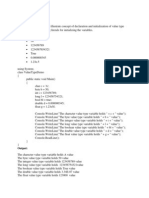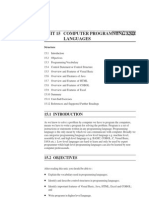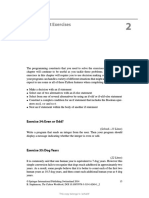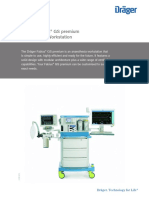Mouse Programing C++
Uploaded by
Muhammad AliMouse Programing C++
Uploaded by
Muhammad AliMouse Programming is a topic which every C programmer from beginner to professional needs to have in his toolbox to have a cutting
edge.It will be used almost everywhere. It will embeded in games programming to commerical valued applications.
This tutorial is written Turbo C++ 3.0 IDE and install in folder C:\TC. I recommend to use same IDE and settings to avoid any uncompatibility.
Basic Fundamentals:
Before we start programming we must first understand some principles on which mouse programming is based.
First thing you must know how to tell a mouse to do anything. In actual we do not communicate with mouse directly but through the driver provided. We use "Interrupts" to get access to this driver. Each device provide by computer has its own port and more or less we access these ports.
Each device has a unique port which is a hexadecimal value and value is designed to be machine independent enhancing portability of program.
Mouse has port 0X33 attached to it and similarly keyboard has attach port 0X60.
We also make use of address registers. These are basically UNION of type REGS defined in "dos.h". We use two registers to communicate to a device driver one for input and one for output.
We send value to device driver through the input register and recieve information in it embedded in output register.
AX Register
We can access various mouse functions using different values of AX input Register and passing those values to mouse port using a interrupt.
The Functions are listed below - Here AX, BX, CX and DX are members of UNION REGS and more or less integers.
Input
Function Performed
Returns
AX = 0
Get Mouse Status
AX Value = FFFFh support is available.
AX Value = 0 ,support is not available.
AX = 1
Show Mouse Pointer
Nothing
AX = 2
Hide Mouse Pointer
Nothing
AX = 3
Mouse Position
CX = Mouse X Coordinate
DX = Mouse Y Coordinate
Ax = 3
Mouse Button Press
BX = 0 No Key Is Pressed
BX = 1 Left Button is Pressed
BX = 2 Right Button is Pressed
BX = 3 Centre Button is Pressed
Ax = 7
Set Horizontal Limit
Nothing
CX = MaxX1
DX =MaxX2
Ax = 8
Set Vertical Limit
Nothing
CX = MaxX1
DX =MaxX2
Detecting Mouse
Before you start your mouse program you should always check whether the mouse programming is supported or not.
If somehow mouse fails to initialise you should always make sure that either program terminates or employ a error handling approach that maybe shift to keyboard interface .
To do mouse programming you must include <dos.h>. We use a function called int86() to access "interupts".
To detect mouse we use a function name detect_mouse() which has following code -
#include <dos.h>
union REGS in, out; void detect_mouse () { in.x.ax = 0; int86 (0X33,&in,&out); if (out.x.ax == 0) printf ("\nMouse Failed To Initialize"); else
printf ("\nMouse was Succesfully Initialized"); }
int main ()
{ detect_mouse (); getch (); return 0; }
Showing and Hiding Mouse
Now first we show mouse on screen .
Mouse works both in text mode and graphic mode. In text mode it looks like a square while in graphics mode it looks like a pointer.
Mouse Programming in Text Mode
It was produced from adding a function showmouse_text() to above code so code becomes -
#include <dos.h>
union REGS in, out;
void detect_mouse () { in.x.ax = 0; int86 (0X33,&in,&out); if (out.x.ax == 0) printf ("\nMouse Failed To Initialize");
else printf ("\nMouse was Succesfully Initialized"); } void showmouse_text ()
{ in.x.ax = 1; int86 (0X33,&in,&out); }
int main ()
{ detect_mouse (); showmouse_text (); getch (); return 0; }
Mouse Programming in Graphics Mode
This is achieved using a function showmouse_graphics() added to above code while removing showmouse_text() from main.
#include <dos.h> #include <graphics.h>
union REGS in, out;
void detect_mouse () { in.x.ax = 0; int86 (0X33,&in,&out); if (out.x.ax == 0) printf ("\nMouse Failed To Initialize"); else printf ("\nMouse was Succesfully Initialized"); }
void showmouse_text () { in.x.ax = 1; int86 (0X33,&in,&out); }
void showmouse_graphics () { int gdriver = DETECT, gmode, errorcode; initgraph(&gdriver, &gmode, "c:\\tc\\bgi"); in.x.ax = 1;
int86 (0X33,&in,&out); getch (); closegraph (); }
int main ()
{ detect_mouse (); showmouse_graphics (); getch (); return 0; }
Next we do realtively simple task of hiding mouse using a function hide_mouse() as shown below -
#include <dos.h> #include <graphics.h> union REGS in, out;
void detectmouse () { in.x.ax = 0; int86 (0X33,&in,&out); if (out.x.ax == 0) printf ("\nMouse Failed To Initialize"); else printf ("\nMouse was Succesfully Initialize"); }
void showmouse_text ()
{ in.x.ax = 1; int86 (0X33,&in,&out); }
void showmouse_graphics ()
{ int gdriver = DETECT, gmode, errorcode; initgraph(&gdriver, &gmode, "c:\\tc\\bgi"); in.x.ax = 1; int86 (0X33,&in,&out); getch ();
closegraph (); }
void hide_mouse () { in.x.ax = 2; int86 (0X33,&in,&out); }
int main ()
{ detect_mouse (); showmouse_graphics (); hide_mouse (); getch (); return 0; }
Detecting Input
We will now work on a important aspect of mouse programming "Detecting Clicks" i.e. Taking Inputs.
We make use of an aditional function known as kbhit ( ). This functions returns zero till any keypress and when a key is press it returns 1.
kbhit() is used to run an infinite while loop.
For detecting mouseclicks we use a function called detect() which displays on screen the respective button clicked. Press any keyboad key to exit the loop.
#include <dos.h>
#include <graphics.h>
union REGS in, out;
void detect_mouse ()
{ in.x.ax = 0; int86 (0X33,&in,&out); if (out.x.ax == 0) printf ("\nMouse Failed To Initialize"); else printf ("\nMouse was Succesfully Initialized"); }
void showmouse_text ()
{ in.x.ax = 1;
int86 (0X33,&in,&out); }
void showmouse_graphics ()
{ int gdriver = DETECT, gmode, errorcode; initgraph(&gdriver, &gmode, "c:\\tc\\bgi"); in.x.ax = 1; int86 (0X33,&in,&out); getch (); closegraph (); }
void hide_mouse ()
{ in.x.ax = 2; int86 (0X33,&in,&out); }
void detect ()
{ while (!kbhit () ) { in.x.ax = 3; int86 (0X33,&in,&out); if (out.x.bx == 1) printf ("Left"); if (out.x.bx == 2) printf ("Right");
if (out.x.bx == 3) printf ("Middle"); delay (200); // Otherwise due to quick computer response 100s of words will get print } }
int main ()
{ detect_mouse (); showmouse_text (); detect (); hide_mouse (); getch (); return 0; }
Mouse Coordinates
We can obtain the coordinates of the mouse using same service 3 but using different elments of the union .
This function has a prime use in games programming, application designing and GUI development. Different decisions are taken on same left button click, its the postion of click that matters.
BX element of output registers stores the X Coordinate of the postion of mouse at time of calling function.
CX element of output registers stores the Y Coordinate of the postion of mouse at time of calling function.
Now we demonstrate the use of this function by modifying detect function above to display x and y coordinates on screen when left click is pressed.
Code will be as followed -
#include <dos.h> #include <graphics.h>
union REGS in, out;
void detect_mouse () { in.x.ax = 0; int86 (0X33,&in,&out); if (out.x.ax == 0) printf ("\nMouse Failed To Initialize"); else printf ("\nMouse was Succesfully Initialized"); }
void showmouse_text () { in.x.ax = 1; int86 (0X33,&in,&out); }
void showmouse_graphics () { int gdriver = DETECT, gmode, errorcode; initgraph(&gdriver, &gmode, "c:\\tc\\bgi"); in.x.ax = 1; int86 (0X33,&in,&out); getch (); closegraph (); }
void hide_mouse () { in.x.ax = 2; int86 (0X33,&in,&out); }
void detect () { while (!kbhit () ) { int x,y; in.x.ax = 3; int86 (0X33,&in,&out);
if (out.x.bx == 1) { x = out.x.cx; y = out.x.dx; printf ("\nLeft || X - %d Y - %d", x, y); } if (out.x.bx == 2) printf ("\nRight"); if (out.x.bx == 3) printf ("\nMiddle"); delay (200); // Otherwise due to quick computer response 100s of words will get print } }
int main ()
{ detect_mouse (); showmouse_text (); detect (); hide_mouse (); getch (); return 0; }
Restricting Mouse
We now restrict the mouse in particular rectangle .
We create a function called restrict which takes four paramters, two cartesian points each containing one x coordinate and one y coordinate.
First point mentions the top of the rectangle while second point mention the bottom bottom point of rectangle.
This service can be quite handy in special circumstances, for eg - if you want to restrict your mouse in one particular size window in GUI or In Games Programming.
#include <dos.h>
#include <graphics.h>
#include <conio.h>
#include <stdio.h>
union REGS in, out;
void restrict (int x1,int y1,int x2, int y2)
in.x.ax = 7;
in.x.cx = x1;
in.x.dx = x2;
int86 (0X33,&in,&out);
in.x.ax = 8;
in.x.cx = y1;
in.x.dx = y2;
int86 (0X33,&in,&out);
void detect_mouse ()
in.x.ax = 0;
int86 (0X33,&in,&out);
if (out.x.ax == 0)
printf ("\nMouse Fail To Initialize");
else
printf ("\nMouse Succesfully Initialize");
void showmouse_text ()
in.x.ax = 1;
int86 (0X33,&in,&out);
void showmouse_graphics ()
int gdriver = DETECT, gmode, errorcode;
initgraph(&gdriver, &gmode, "c:\\tc\\bgi");
in.x.ax = 1;
int86 (0X33,&in,&out);
getch ();
closegraph ();
void hide_mouse ()
in.x.ax = 2;
int86 (0X33,&in,&out);
void detect ()
while (!kbhit () )
int x,y;
in.x.ax = 3;
int86 (0X33,&in,&out);
if (out.x.bx == 1)
x = out.x.cx;
y = out.x.dx;
printf ("\nLeft || X - %d Y - %d", x, y);
if (out.x.bx == 2) printf ("\nRight");
if (out.x.bx == 3) printf ("\nMiddle");
delay (200); // Otherwise due to quick computer response 100s
of words will get print
int main ()
detect_mouse ();
showmouse_text ();
restrict (100,100,500,500); // Change values here to create
different mouse movement space.
detect ();
hide_mouse ();
getch ();
return 0;
PS:- library graphics.h is incompatible with vista (working in Normal mode), because Vista doesnt support TC in fullscreen mode.
You might also like
- Install and Activate Adobe Photoshop CC 2014No ratings yetInstall and Activate Adobe Photoshop CC 20142 pages
- T.Y. B.SC Computer Science Slips Java Mar - Oct Pattern 2013-Min PDF100% (1)T.Y. B.SC Computer Science Slips Java Mar - Oct Pattern 2013-Min PDF25 pages
- Fundamentals of Computer Programming Languages UPTNo ratings yetFundamentals of Computer Programming Languages UPT29 pages
- Adobe L Adobe Dreamweaver Help and Tutorials PDFNo ratings yetAdobe L Adobe Dreamweaver Help and Tutorials PDF688 pages
- Be Sharp With C# (Chapter 1, Controls and Code)0% (1)Be Sharp With C# (Chapter 1, Controls and Code)21 pages
- Document Evidence of Professional Practice Template 0No ratings yetDocument Evidence of Professional Practice Template 014 pages
- Adobe Creative Suite CS6 Ebooks Collection English - PDF - Collection - 2.20No ratings yetAdobe Creative Suite CS6 Ebooks Collection English - PDF - Collection - 2.204 pages
- CBSE Class 8 Computer Science - Introduction To Computer Security100% (1)CBSE Class 8 Computer Science - Introduction To Computer Security4 pages
- Advances in Computer Science and EngineeringNo ratings yetAdvances in Computer Science and Engineering472 pages
- PEN-103-Computer Programing Examples A-July 2019No ratings yetPEN-103-Computer Programing Examples A-July 201919 pages
- Unit - 5 (C#.NET Programming) User Controls, Reports & SetupNo ratings yetUnit - 5 (C#.NET Programming) User Controls, Reports & Setup13 pages
- Dynamic HTML: Cascading Style Sheets (CSS)No ratings yetDynamic HTML: Cascading Style Sheets (CSS)66 pages
- Range ("A1:A10) .Value "Visual Basic " Range ("C11") .Value Range ("A11") .Value Range ("B11") .Value Range ("A1") 100 Range ("A1") .Value "VBA"No ratings yetRange ("A1:A10) .Value "Visual Basic " Range ("C11") .Value Range ("A11") .Value Range ("B11") .Value Range ("A1") 100 Range ("A1") .Value "VBA"11 pages
- Modular Structured Approach of Programing FundamentalsNo ratings yetModular Structured Approach of Programing Fundamentals337 pages
- C Language Programming-Practise Probs by Er - Anchal Kamra PDFNo ratings yetC Language Programming-Practise Probs by Er - Anchal Kamra PDF31 pages
- 855 Assignment No. 1 Computers in Education100% (2)855 Assignment No. 1 Computers in Education13 pages
- Dräger Fabius GS Premium Anaesthesia WorkstationNo ratings yetDräger Fabius GS Premium Anaesthesia Workstation8 pages
- Compro Pertamina Inggris Februari 2014 IsiNo ratings yetCompro Pertamina Inggris Februari 2014 Isi20 pages
- Jual ACER Aspire All-In-1 Multi Media PC AZ5710 - BeraniMurahNo ratings yetJual ACER Aspire All-In-1 Multi Media PC AZ5710 - BeraniMurah4 pages
- CompactRIO and Single-Board RIO Specification Comparison - National InstrumentsNo ratings yetCompactRIO and Single-Board RIO Specification Comparison - National Instruments3 pages
- Dummies Guide To Engineering Data Management100% (1)Dummies Guide To Engineering Data Management33 pages
- 1FK7042-2AF21-1QB0 MB Zaxis Withbrake PDFNo ratings yet1FK7042-2AF21-1QB0 MB Zaxis Withbrake PDF1 page
- Syllabus MSC IT 2015 Batch Onwards PTU DDENo ratings yetSyllabus MSC IT 2015 Batch Onwards PTU DDE41 pages
- T.Y. B.SC Computer Science Slips Java Mar - Oct Pattern 2013-Min PDFT.Y. B.SC Computer Science Slips Java Mar - Oct Pattern 2013-Min PDF
- Fundamentals of Computer Programming Languages UPTFundamentals of Computer Programming Languages UPT
- Document Evidence of Professional Practice Template 0Document Evidence of Professional Practice Template 0
- Adobe Creative Suite CS6 Ebooks Collection English - PDF - Collection - 2.20Adobe Creative Suite CS6 Ebooks Collection English - PDF - Collection - 2.20
- CBSE Class 8 Computer Science - Introduction To Computer SecurityCBSE Class 8 Computer Science - Introduction To Computer Security
- Unit - 5 (C#.NET Programming) User Controls, Reports & SetupUnit - 5 (C#.NET Programming) User Controls, Reports & Setup
- Range ("A1:A10) .Value "Visual Basic " Range ("C11") .Value Range ("A11") .Value Range ("B11") .Value Range ("A1") 100 Range ("A1") .Value "VBA"Range ("A1:A10) .Value "Visual Basic " Range ("C11") .Value Range ("A11") .Value Range ("B11") .Value Range ("A1") 100 Range ("A1") .Value "VBA"
- Modular Structured Approach of Programing FundamentalsModular Structured Approach of Programing Fundamentals
- C Language Programming-Practise Probs by Er - Anchal Kamra PDFC Language Programming-Practise Probs by Er - Anchal Kamra PDF
- Extensible Markup Language XML A Complete GuideFrom EverandExtensible Markup Language XML A Complete Guide
- Jual ACER Aspire All-In-1 Multi Media PC AZ5710 - BeraniMurahJual ACER Aspire All-In-1 Multi Media PC AZ5710 - BeraniMurah
- CompactRIO and Single-Board RIO Specification Comparison - National InstrumentsCompactRIO and Single-Board RIO Specification Comparison - National Instruments

























































































